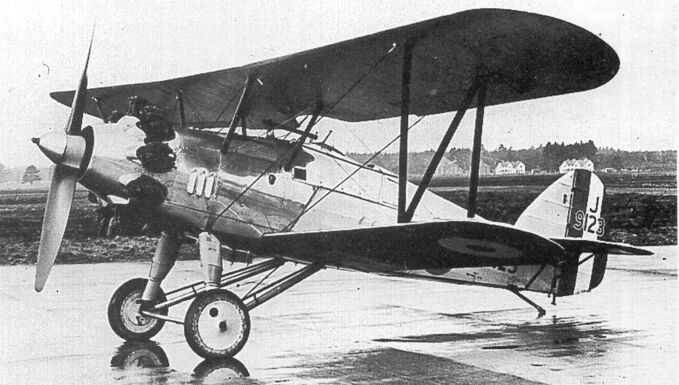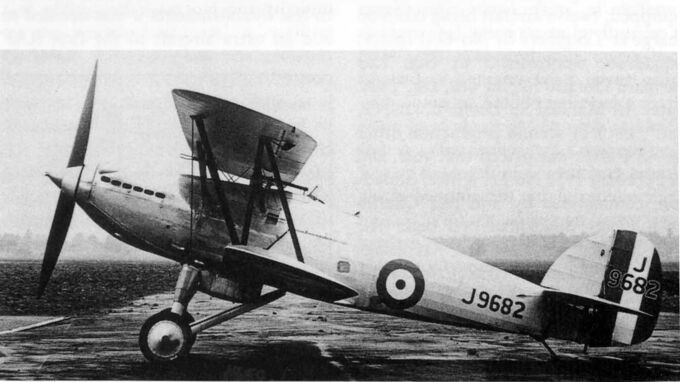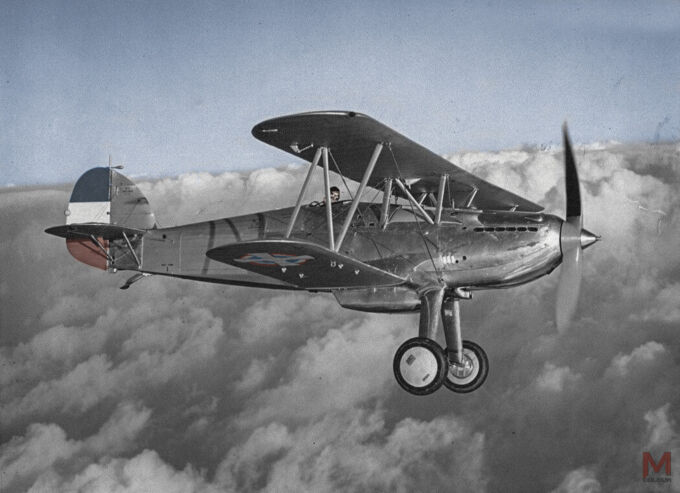The Hawker Fury was a British biplane fighter used by the Royal Air Force in the 1930s. It was a fast and agile aircraft and one of the first aircraft of the RAF to achieve speeds exceeding 200 mph in level flight. It was the fighter counterpart to the Hawker Hart light bomber. The Hawker Nimrod was a carrier-based biplane fighter which shared many similarities with the Fury.
Design, Development and Variants:
Hawker Fury:
Designed by Sydney Camm at Hawker Aircraft Ltd., the Fury was a development of the earlier Hawker Hornet (Hawker F.20/27), itself an experimental fighter demonstrating promising performance characteristics and sometimes known as the Interceptor. It was a single-engined, single-seat biplane fighter featuring a metal frame covered with fabric. The upper fuselage was slightly humped and the pilot sat in an open cockpit behind the upper wing. The Hornet first flew in August 1928, powered by the 450 horsepower nine-cylinder Bristol Jupiter, being re-engined with a 520 horsepower Bristol Mercury VI in 1930.
The Air Ministry, recognizing the potential in the Hornet’s speed and maneuverability, issued Specification F.13/30 to formalize its requirements for a new interceptor. The result was the Fury, a lighter, more refined aircraft equipped with a Rolls-Royce Kestrel liquid-cooled V-12 engine, offering a substantial increase in speed and performance compared to its predecessors.
In structural terms, the Fury retained the biplane layout, with staggered wings and fixed undercarriage, but it was built using a hybrid construction of metal tubing and fabric, typical of the era but executed with unusual finesse. Its design prioritized aerodynamic cleanliness and agility, allowing it to become one of the first aircraft of the RAF capable of exceeding 200 mph (322 km/h) in level flight.
Variants:
- Hawker Hornet: A single-seat fighter prototype powered by a Rolls-Royce F.XIA and later on by a 480 horsepower F.XIS engine. One built.
- Fury Mk I: A single-seat fighter version powered by a 525 horsepower Rolls-Royce Kestrel IIs piston engine.
- Fury Series 1A: A single-seat fighter for Yugoslavia powered by a Kestrel IIS piston engine. One delivered with a 500 horsepower Hispano-Suiza 12 NB engine, later re-fitted with a Kestrel, while a second was used for trials with a 720 horsepower Lorraine Petrel HFrs engine. Six built.
- Intermediate Fury: A test and trials aircraft used as a prototype. One built with British civil registration G-ABSE.
- High Speed Fury: A single-seat high-speed trials and test aircraft used as a prototype, which would then be developed into the Fury Mk II. One built.
- Fury Mk II: A single-seat fighter version, powered by a 640 horsepower Rolls-Royce Kestrel VI engine. 112 built.
- Yugoslav Fury: A revised single-seat fighter for Yugoslavia, powered by 745 horsepower Kestrel XVI engine, and equipped with a low drag radiator and Dowty cantilever undercarriage as well as an additional two machine guns under wing. Ten built by Hawker, with a further 40 licence built in Yugoslavia.
- Persian Fury: A single-seat fighter for Persia. 16 aircraft powered by a Pratt & Whitney Hornet S2B1g radial engine, driving a three-bladed propeller and a further six aircraft powered by a 550 horsepower Bristol Mercury VISP radial engine, fitted with a two-bladed propeller, were ordered between 1933 and 1934.
- Norwegian Fury: A single trial aircraft, fitted with a 530 horsepower Armstrong-Siddeley Panther IIIA radial engine built for Norway.
- Portuguese Fury: Three Fury Mk.Is fitted with a Rolls-Royce Kestrel II piston engine built for Portugal.
- Spanish Fury: An improved version of the Fury Mk.I, with three aircraft being fitted with a 700 horsepower Hispano-Suiza 12Xbrs engine and built for Spain.
Hawker Nimrod:
While the Fury was optimized for land-based operations, the Hawker Nimrod, initially called Norn, was developed specifically for use by the Fleet Air Arm of the Royal Navy. Intending to replace the older Fairey Flycatchers, the navy expressed interest in acquiring Nimrods despite initial reluctance due to the use of a liquid-cooled engine, considered less suitable for naval aircraft than an air-cooled one.
First flown in 1931, the Nimrod was effectively a navalized Fury adapted for carrier operations with structural reinforcements, arrestor hook fittings, and provision for flotation gear. Based on the experimental High Speed Fury fighter, the upper wing panels were swept back, a more powerful Rolls-Royce Kestrel VFP engine was installed, and the landing gear was slightly modified. The new Nimrod Mk.II flew in this configuration in September 1933.
Variants:
- Nimrod I: Equipped with a 477 horsepower Rolls-Royce Kestrel IIMS engine. 57 built.
- Nimrod II: A modified version with a swept-wing, powered by a 608 horsepower Rolls-Royce Kestrel IIS or VFp engine. 30 built.
- Danish Nimrod: Two aircraft exported to Denmark, powered by a Rolls-Royce Kestrel IIIS engine. Two built.
- Nimrodderne: A single-seat fighter for the Royal Danish Navy. Ten built under licence in Denmark.
- AXH1: A single Hawker Nimrod I supplied to the Imperial Japanese Navy Air Service for evaluation in 1934.
Operational History:
Hawker Fury:
The Hawker Fury’s active service life was relatively short. Upon entering service in the early 1930s, it was a clear step forward in terms of speed, climb rate, and maneuverability. Its performance surpassed contemporaries such as the Bristol Bulldog and Gloster Gamecock, marking a new standard for British air defense.
Assigned initially to No. 1 Squadron RAF, the Fury was well-received by its pilots, who appreciated its responsiveness and speed. Its sleek appearance and high performance also made it a favorite at air shows and in public demonstrations, helping to boost public perception of British airpower during a period of rising geopolitical tensions.
However, the rapid pace of aeronautical advancement in the 1930s quickly eroded the Fury’s frontline relevance. By 1937, it had been replaced in RAF service by more advanced designs such as the Gloster Gladiator, which itself would soon be overtaken by monoplane fighters like the Hawker Hurricane and the Supermarine Spitfire.
Despite its retirement from frontline duties, the Fury continued to serve abroad. Exported aircraft remained in use into the early stages of the Second World War. During the Axis invasion of Yugoslavia in April 1941, Yugoslav Furies, many already outdated and outmatched, were thrown into combat against modern German aircraft. Despite the odds, some units managed to claim limited successes against enemy bombers and fighters, although most were destroyed in the air or on the ground in the campaign’s opening days.
In South Africa, the Fury was retained in a training role, helping to prepare pilots for operational conversion to more modern aircraft. Similarly, Iranian Furies served primarily as training and liaison aircraft before being phased out in favor of more capable types. Some were used by the South African Air Force against Italian forces in East Africa in 1940, where they destroyed two Caproni bombers and strafed multiple airfields, destroying fighters and bombers on the ground.
Hawker Nimrod:
The Hawker Nimrod’s operational history is, unfortunately, relatively short. It played a similar role to the Fury in preparing the Fleet Air Arm for the transition to more modern aircraft. Operating from aircraft carriers such as HMS Courageous and HMS Furious, Nimrods served with frontline squadrons until being gradually replaced by types like the Gloster Sea Gladiator.









